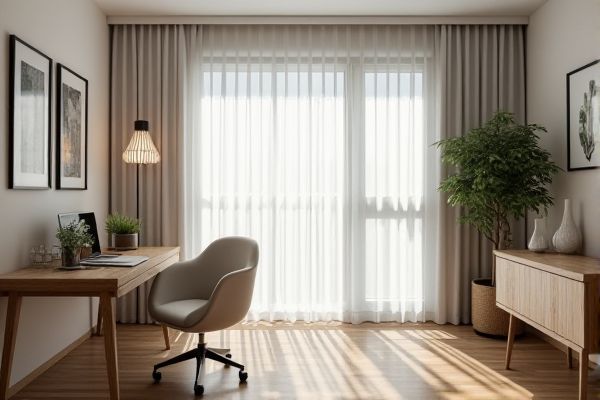
Vertical blinds offer precise light control and space efficiency, making them ideal for a focused study environment. Discover which option suits Your study needs better by exploring the full comparison in the article.
Table of Comparison
| Feature | Vertical Blinds | Curtains |
|---|---|---|
| Light Control | Adjustable slats allow precise light regulation; ideal for study rooms. | Less precise; rely on fabric thickness and layering. |
| Privacy | High privacy with adjustable slats. | High privacy; depends on fabric opacity. |
| Installation | Require headrail fixation; suitable for large windows. | Simple rod or track installation. |
| Maintenance | Easy to clean; wipe slats with cloth. | Require washing or dry cleaning. |
| Durability | Resistant to fading and wear; long-lasting. | Fabric may fade or tear over time. |
| Style & Appearance | Modern, minimalistic look; available in neutral tones. | Varied styles and fabrics; customizable for study ambiance. |
| Noise | Can be noisy if slats move. | Soft fabric dampens noise. |
| Cost | Moderate price; long-term investment. | Varies widely; from budget-friendly to premium. |
Introduction: Choosing Window Treatments for a Study
Vertical blinds offer precise light control and space efficiency, making them ideal for a study where concentration is key. Curtains provide better insulation and aesthetic warmth, enhancing comfort during long work sessions. Your decision depends on whether you prioritize functionality or ambiance in your workspace.
Vertical Blinds vs Curtains: An Overview
Vertical blinds offer precise light control and are ideal for study rooms where adjustable natural light enhances focus, while curtains provide better insulation and sound absorption, creating a cozy atmosphere for concentration. Your choice depends on whether you prioritize light management or a quieter environment during study sessions. Both options differ in maintenance, with blinds requiring less frequent cleaning compared to fabric curtains that can accumulate dust.
Light Control and Privacy Comparison
Vertical blinds offer superior light control compared to curtains by allowing precise adjustment of slats to regulate brightness and reduce glare in your study. Curtains provide less flexibility, typically requiring full opening or closing, which can limit light modulation throughout the day. For privacy, vertical blinds enable selective visibility control without sacrificing natural light, whereas curtains provide complete privacy only when fully drawn.
Aesthetic Appeal and Design Flexibility
Vertical blinds offer a sleek, modern aesthetic that complements minimalist and contemporary study spaces, providing clean lines and a streamlined appearance. Curtains deliver greater design flexibility through a wide range of fabrics, colors, patterns, and textures, allowing you to tailor the ambiance and style of your study to personal taste. Choosing between vertical blinds and curtains depends on whether you prefer a minimalist look or a more customizable, cozy atmosphere for your study environment.
Ease of Maintenance and Cleaning
Vertical blinds offer superior ease of maintenance compared to curtains due to their smooth, wipe-clean surfaces that resist dust and stains, making them ideal for study environments. Curtains often require frequent washing or dry cleaning, which can be time-consuming and less practical for busy study spaces. You can save time and effort by choosing vertical blinds that maintain a neat and hygienic setting with minimal upkeep.
Noise Reduction Capabilities
Vertical blinds offer moderate noise reduction by slightly dampening external sounds, but their hard surfaces and gaps between slats limit effectiveness. Curtains, especially those made from thick, heavy, or multilayered fabrics, provide superior noise insulation by absorbing and blocking a wider range of sound frequencies. For your study area, choosing dense, lined curtains can significantly enhance concentration by reducing ambient noise.
Energy Efficiency and Insulation
Vertical blinds offer superior energy efficiency by allowing precise control over light and airflow, reducing heat gain in summer and heat loss in winter. Curtains, especially those made from heavy or thermal-insulating fabrics, provide excellent insulation by trapping air between the window and the room, enhancing thermal retention. Combining vertical blinds with insulated curtains can maximize energy savings and maintain consistent indoor temperatures during study sessions.
Space-Saving Considerations
Vertical blinds offer a space-saving advantage by fitting closely within window frames, making them ideal for smaller study areas where maximizing floor space is crucial. Curtains often require more clearance for rod installation and fabric draping, which can encroach on limited room dimensions. Choosing vertical blinds can help optimize your study's layout by minimizing obstruction and maintaining a sleek profile.
Cost Analysis: Initial and Long-Term
Vertical blinds typically have a lower initial cost compared to curtains, making them a budget-friendly option for your study. Over time, curtains may incur higher maintenance costs due to frequent cleaning and potential fabric wear, while vertical blinds offer durability and ease of cleaning, reducing long-term expenses. Considering energy efficiency, curtains can provide better insulation, potentially lowering heating and cooling costs in your study space.
Final Verdict: Which Suits a Study Best?
Vertical blinds offer precise control over light and privacy, making them ideal for a study environment where focus and adjustable lighting are crucial. Curtains provide better sound insulation and a cozier atmosphere, but may block natural light more significantly. Your choice depends on whether you prioritize light control and minimal distraction (vertical blinds) or thermal insulation and aesthetic warmth (curtains).
 homyna.com
homyna.com